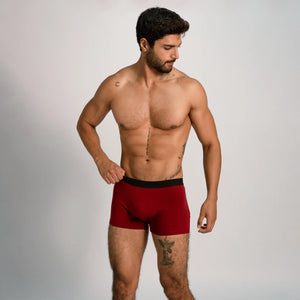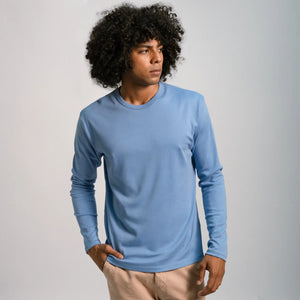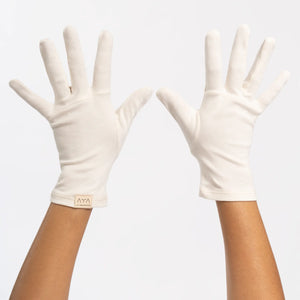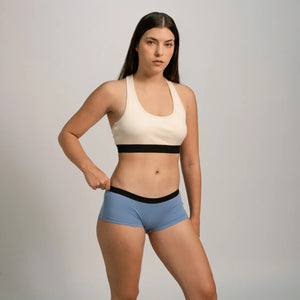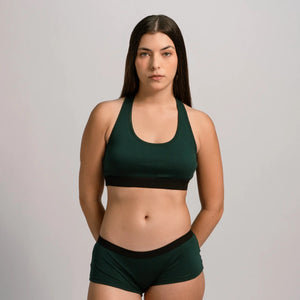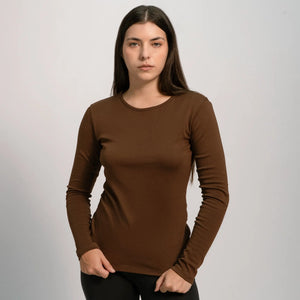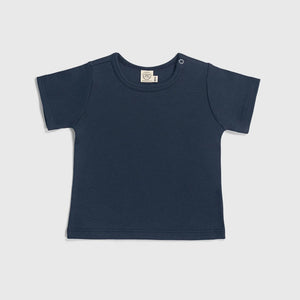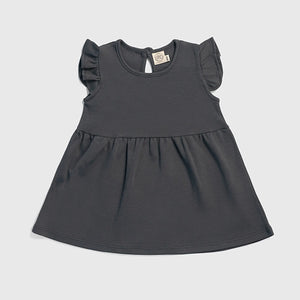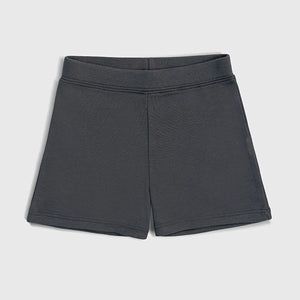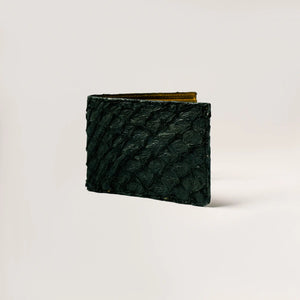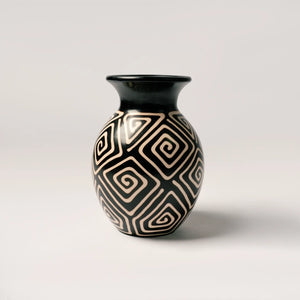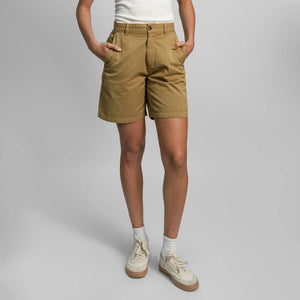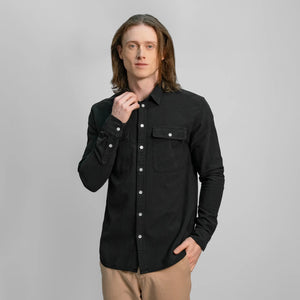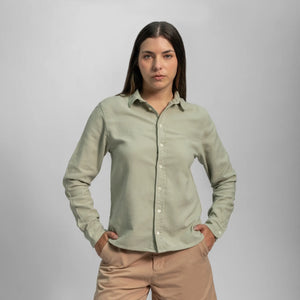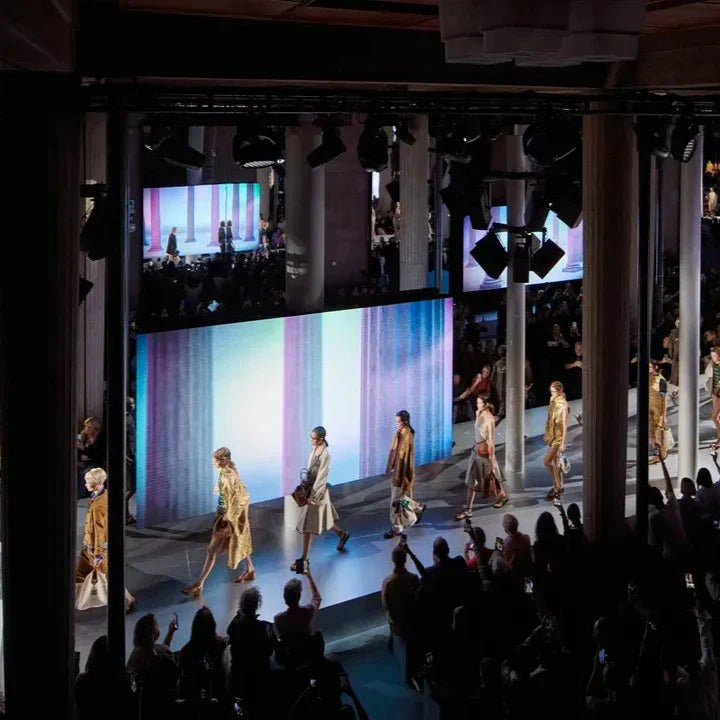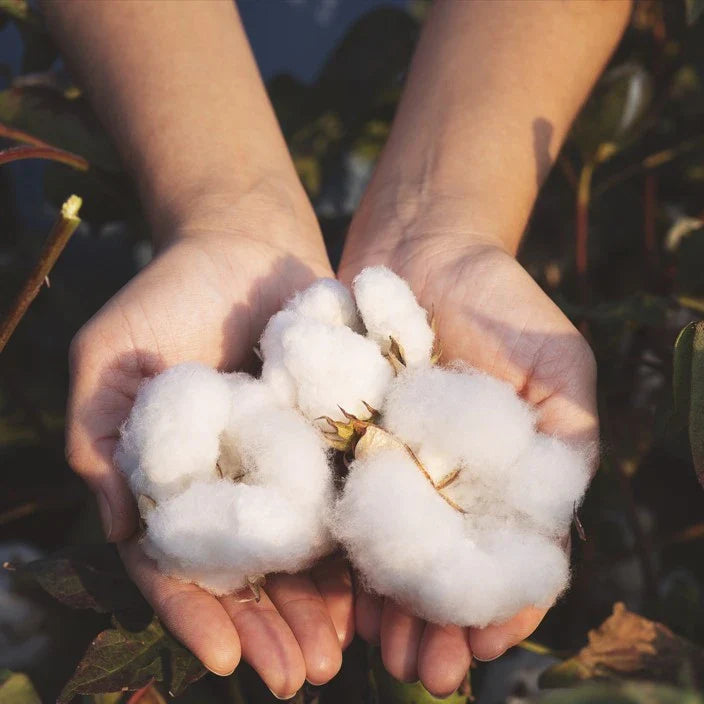The Ethical Look:
Beyond the Surface of Sustainable Clothing
.
AYA | JANUARY 29, 2025
READING TIME: 6 minutes
By Jordy Munarriz & Lesia Tello
The fashion industry is undergoing a profound transformation. Consumers are no longer solely swayed by fleeting trends and passing styles; they're seeking deeper meaning and ethical considerations in their clothing choices. This shift in consciousness has given rise to the "Ethical Look" —a movement that goes beyond aesthetics and delves into the social and environmental impact of what we wear.
The Ethical Look isn't just about wearing organic cotton or recycled fabrics; it's about aligning your values with your wardrobe. It's about considering the entire lifecycle of a garment, from the sourcing of raw materials to the treatment of workers and the disposal of the final product. It's about making conscious choices that support a more sustainable and equitable fashion industry.
The Growing Demand for Ethical Fashion
This shift towards ethical considerations in fashion is driven by a growing awareness of the industry's negative impacts.
Environmental Damage
The fashion industry is a major polluter, contributing to greenhouse gas emissions, water contamination, and textile waste. A 2017 report by the House of Commons Environmental Audit Committee revealed that the fashion industry is responsible for 10% of global carbon emissions [1].
Social Exploitation
Many garment workers, particularly in developing countries, face exploitative working conditions, including low wages, long hours, and unsafe environments. A 2018 study by the Clean Clothes Campaign found that less than 2% of garment workers globally earn a living wage [2].
Consumer Activism
Consumers are increasingly demanding greater transparency and accountability from fashion brands. The Fashion Revolution movement, for example, encourages consumers to ask brands "Who Made My Clothes?" to raise awareness about ethical sourcing and production practices [3].
Such consumers—those who worry about how their purchasing decisions impact the world in general—could have a difficult time orienting themselves amongst the abundance of brands claiming to be committed to the same ethical principles in the clothing market [4]. With these articles, we seek to educate and make our intentions transparent, strengthening their trust in us.
Key Elements of the Ethical Look
The Ethical Look encompasses a wide range of considerations, including:
Sustainable Materials
Choosing fabrics made from organic cotton, recycled fibers, or innovative plant-based materials that minimize environmental impact. At AYA, we prioritize organic cotton and alpaca wool, sourced with respect for the environment and animal welfare.
Ethical Production
Supporting brands that prioritize fair labor practices, safe working conditions, and fair wages for garment workers. We work hand in hand with skilled artisans in Peru who continue to work while respecting their traditions and in safe conditions
Reduced Consumption
Buying less clothing, choosing durable and timeless pieces, and embracing secondhand or vintage fashion. At AYA, we encourage our community to buy consciously and choose quality over quantity, based on objective garments for the intended use.
Transparency and Traceability
Seeking out brands that are transparent about their supply chains and production processes, allowing consumers to make informed choices. We're open about our production process, so you can feel good about the clothes you wear.
Animal Welfare
Opting for cruelty-free materials and avoiding products made from animal fur or leather.
Circular Fashion
Supporting brands that embrace circularity principles, such as designing for durability, recyclability, and reuse. We believe in extending the life of our garments by teaching garment care strategies and sharing strategies for exchanging, reusing or recycling garments through our networks and blogs.

One way for ethical consumers to assess how well a brand aligns with the issues and values they care about is by visiting the company's website. Here, in addition to marketing its products, company websites often include valuable information about a brand’s core values and the ethical principles that form part of its Corporate Social Responsibility (CSR) [4,5,6] . Many fashion brands, for instance, have links to their corporate code of ethics and commitments to sustainability, which functions as the company's "constitution" [4] and AYA is one of them. We share with you our commitment to the environment and to transparency with our customers.
While more consumers are beginning to view ethical fashion favorably, it remains difficult to decipher how this attitude translates into actual purchasing behavior. It’s unclear whether consumers will spend more for an ethical product [4]. The question of how much consumers truly favor products from socially responsible companies remains complex and varies from one study to the next [4,5].
The Role of Certifications and Labels
Labels related to social conditions in manufacturing have a long history, but in recent years, brands have become increasingly interested in obtaining various types of certifications attesting to their environmental and ethical commitments [4]. Environmental certifications ensure that only chemical substances that are not harmful to the environment are used in manufacturing garments, whether during plant cultivation (such as cotton), fabric spinning, or subsequent production processes [4]. Social or ethical certifications, on the other hand, set minimum standards for workers' rights. There are also certifications that specifically guarantee animal welfare, certifying that the brand does not use animal-derived materials.
The Challenges and Opportunities of Ethical Consumption
One’s “knowledge” of a certain brand constitutes another important tool for ethical consumers when making purchasing decisions. This knowledge often comes from reading the company’s ethical statements or code of conduct, which helps shed light on the brand's values. These codes are one of the primary ways brands communicate their ethical commitments, although they can serve multiple purposes [4].
In today’s globalized fashion world, the vast majority of garments are manufactured far from the places where they are consumed. Around 80% of clothing exports come from undeveloped countries to developed economies [5]. This delocalization brings both challenges and opportunities for the ethical fashion movement. On one hand, it generates an imbalance in environmental impacts and often leads to exploitative labor conditions. Local sourcing and production, however, reduce environmental impacts related to transportation and offer better control over labor practices, though it may conflict with the low-cost model that fast fashion thrives on [5,7]. For example, in Finland, approximately 90% of the garments sold are imported from Asian and Far Eastern countries and 5% from the European Union (EU) and other countries. That means that less than 5% are manufactured in Finland [5].
This is why AYA collects its raw materials and the entire process of making its garments is carried out in Peru, greatly reducing its impact and providing work for people who live in the country that provides the resources.

Source: ENVERTE Paris
Changing Demographics and Preferences
The pandemic also highlighted shifting demographics in the fashion market. Younger consumers, particularly Gen Z and Millennials, became increasingly influential in shaping purchasing trends. Research from the Institute for Sustainable Fashion indicates that younger generations are more likely to support sustainable brands, with 83% of Millennials stating they prefer to buy from companies that share their values [7,8].
Moreover, with the rise of remote work, many consumers reported a preference for comfort over style. A study published in the Journal of Fashion Marketing and Management noted that comfort became the primary driver of clothing purchases for many consumers, with 65% prioritizing comfort in their buying decisions [9]. This trend is likely to persist as remote work becomes a more permanent aspect of many industries.

Changing Demographics and Preferences
The pandemic also highlighted shifting demographics in the fashion market. Younger consumers, particularly Gen Z and Millennials, became increasingly influential in shaping purchasing trends. Research from the Institute for Sustainable Fashion indicates that younger generations are more likely to support sustainable brands, with 83% of Millennials stating they prefer to buy from companies that share their values [7,8].
Moreover, with the rise of remote work, many consumers reported a preference for comfort over style. A study published in the Journal of Fashion Marketing and Management noted that comfort became the primary driver of clothing purchases for many consumers, with 65% prioritizing comfort in their buying decisions [9]. This trend is likely to persist as remote work becomes a more permanent aspect of many industries.

Changing Demographics and Preferences
The pandemic also highlighted shifting demographics in the fashion market. Younger consumers, particularly Gen Z and Millennials, became increasingly influential in shaping purchasing trends. Research from the Institute for Sustainable Fashion indicates that younger generations are more likely to support sustainable brands, with 83% of Millennials stating they prefer to buy from companies that share their values [7,8].
Moreover, with the rise of remote work, many consumers reported a preference for comfort over style. A study published in the Journal of Fashion Marketing and Management noted that comfort became the primary driver of clothing purchases for many consumers, with 65% prioritizing comfort in their buying decisions [9]. This trend is likely to persist as remote work becomes a more permanent aspect of many industries.

Changing Demographics and Preferences
The pandemic also highlighted shifting demographics in the fashion market. Younger consumers, particularly Gen Z and Millennials, became increasingly influential in shaping purchasing trends. Research from the Institute for Sustainable Fashion indicates that younger generations are more likely to support sustainable brands, with 83% of Millennials stating they prefer to buy from companies that share their values [7,8].
Moreover, with the rise of remote work, many consumers reported a preference for comfort over style. A study published in the Journal of Fashion Marketing and Management noted that comfort became the primary driver of clothing purchases for many consumers, with 65% prioritizing comfort in their buying decisions [9]. This trend is likely to persist as remote work becomes a more permanent aspect of many industries.

Ethical Fashion for Generation Z
Unlike previous generations, Generation Z shows a heightened environmental and ethical awareness in their fashion choices. They value sustainability and gravitate toward brands that share their concerns about the environment and ethical practices. This generation is increasingly focused on understanding the textile industry's impact on water pollution, greenhouse gas emissions, overproduction, and the use of sustainable materials [7].
This generation’s demand for eco-friendly products is shaping the future of the industry, as they seek out brands that are authentic in their commitment to sustainability. They increasingly want to make a personal impact by supporting brands that align with their values, which also gives them a sense of personal satisfaction and influence on broader social groups [7].
The Complexity of Ethical Consumption
Ethical fashion encompasses not only good working conditions for workers and the use of organic materials, but also sustainable business models in the countries of origin. However, ethical purchasing decisions are complex. Social motivations, ideals, and ideologies often play a larger role in consumers' decision-making processes than personal concerns [8]. This makes it harder for consumers to separate the ethics of fashion from the pressures of style and price.
For many consumers, sustainability remains a low priority concern when making purchasing decisions. Despite their positive attitudes toward ethical consumption, studies show that altruism, status enhancement, and happiness significantly influence purchasing behavior [7,8]. However, for younger consumers, sustainable fashion is not always a priority, and they may separate fashion from sustainability even if they support the idea of it.
The Future of Ethical Fashion
The Ethical Look is not just about what you wear; it's about the choices you make and the values you stand for. The question remains: to what extent do consumers favor products from socially responsible firms, or avoid those produced irresponsibly? Clothing sustainability is a complex issue, and while the number of ethical consumers is increasing, their buying behavior doesn’t always match their values. With diverse consumer concerns and the challenges posed by the complexity of the fashion industry, it’s clear that sustainability will require ongoing effort and innovation.
At AYA, we're committed to making ethical fashion accessible and stylish. Our collections are crafted from sustainable materials like organic cotton and alpaca wool, and we prioritize fair labor practices throughout our supply chain. By choosing AYA, you're not only investing in high-quality, comfortable garments but also supporting a brand that aligns with the values our society needs to forge real change towards a more sustainable world.
At AYA, we're committed to making ethical fashion accessible and stylish. Our collections are crafted from sustainable materials like organic cotton and alpaca wool, and we prioritize fair labor practices throughout our supply chain. By choosing AYA, you're not only investing in high-quality, comfortable garments but also supporting a brand that aligns with the values our society needs to forge real change towards a more sustainable world.

Glossarykeywords
Circular Fashion:
It is a clothing production and consumption model that seeks to reduce waste and pollution. It is based on economic circularity, which prioritizes the reuse and recycling of materials and products.
Community Clothing:
It refers to clothing brands that adopt ethical fashion, social justice, and sustainability principles while seeking to empower and strengthen local or specific communities.
Consumer Behavior:
They are all the attitudes, preferences, intentions and decisions that govern a consumer throughout the process of buying a product or service.
Generation Z :
It is the group of people born between 1997 and 2012. They are also known as centennials.
Greenhouse gas emissions (GHG):
Trap heat and keep the planet warmer than it would be without it.
Lifecycle of a Garment:
The life cycle of a garment is considered to be linear, where garments are produced, used and discarded (they end up in landfills or are incinerated). Nowadays, the period of reuse and recycling is also included in the life cycle of a garment.
Microplastics:
Tiny plastic particles, smaller than 5mm, found in the environment from the breakdown of larger plastics or industrial processes.
Sustainable fashion:
Clothing made using eco-friendly materials and ethical production practices.
Sustainability:
"Meeting the needs of the present without compromising the ability of future generations to meet their own needs" (ONU, 1987).
Changing Demographics and Preferences
The pandemic also highlighted shifting demographics in the fashion market. Younger consumers, particularly Gen Z and Millennials, became increasingly influential in shaping purchasing trends. Research from the Institute for Sustainable Fashion indicates that younger generations are more likely to support sustainable brands, with 83% of Millennials stating they prefer to buy from companies that share their values [7,8].
Moreover, with the rise of remote work, many consumers reported a preference for comfort over style. A study published in the Journal of Fashion Marketing and Management noted that comfort became the primary driver of clothing purchases for many consumers, with 65% prioritizing comfort in their buying decisions [9]. This trend is likely to persist as remote work becomes a more permanent aspect of many industries.

Authors & Researchers



Jordy Munarriz
Jordy Munarriz
Environmental Engineer with a master's degree in renewable energy and a specialization in sustainability. Researcher and writer, he combines his technical knowledge with his passion for environmental communication, addressing topics of ecological impact and sustainable solutions in the textile industry and beyond.
Environmental Engineer with a master's degree in renewable energy and a specialization in sustainability. Researcher and writer, he combines his technical knowledge with his passion for environmental communication, addressing topics of ecological impact and sustainable solutions in the textile industry and beyond.
Lesia Tello
Biologist and researcher specializing in biochemistry, with a master’s degree in education. Passionate about scientific inquiry, she explores the complexities of life and the processes that sustain it. Her work focuses on the intersection of science, education, and communication, making scientific knowledge accessible and impactful.



Jordy Munarriz
Environmental Engineer with a master's degree in renewable energy and a specialization in sustainability. Researcher and writer, he combines his technical knowledge with his passion for environmental communication, addressing topics of ecological impact and sustainable solutions in the textile industry and beyond.
Lesia Tello
Lesia Tello
Biologist and researcher specializing in biochemistry, with a master’s degree in education. Passionate about scientific inquiry, she explores the complexities of life and the processes that sustain it. Her work focuses on the intersection of science, education, and communication, making scientific knowledge accessible and impactful.
Biologist and researcher specializing in biochemistry, with a master’s degree in education. Passionate about scientific inquiry, she explores the complexities of life and the processes that sustain it. Her work focuses on the intersection of science, education, and communication, making scientific knowledge accessible and impactful.
References:
[1] House of Commons Environmental Audit Committee. (2017). Fixing Fashion: Clothing Consumption and Sustainability. London: House of Commons.
[2] Clean Clothes Campaign. (2018). Tailored Wages 2018: The state of pay in the global garment industry. Amsterdam: Clean Clothes Campaign.
[3] Fashion Revolution. Who Made My Clothes? [Internet]. 2025 [cited 2025 Jan 27]. Available from: https://www.fashionrevolution.org/
[4]Cerchia RE, Piccolo K. The Ethical Consumer and Codes of Ethics in the Fashion Industry. Laws. 2019;8(4):23. doi:10.3390/laws8040023.
[5] Niinimäki K. Ethical foundations in sustainable fashion. Text Cloth Sustain. 2015;1(3). doi:10.1186/s40689-015-0002-1.
[6] Singh, S. (2024). Cultivating Circular Design in Fashion Education: Navigating Challenges and Fostering Sustainable Practices. NIFT Journal of Fashion, 3, 189-204. Available from: https://nift.ac.in/sites/default/files/2024-05/ejournal/volume-3/NIFT%20Journal%20of%20Fashion%20Volume-3.pdf#page=189
[7] Escourido-Calvo M, Prado-Dominguez AJ, Martin-Palmero F. Generation Z, Circular Fashion, and Sustainable Marketing. Int J Digital Mark Manag Innov. 2025;1(1):23. doi:10.4018/IJDMMI.367035.
[8] Vehmas K, Raudaskoski A, Heikkilä P, Harlin A, Mensonen A. Consumer attitudes and communication in circular fashion. J Fashion Mark Manag. 2018;22(3):286-300. doi:10.1108/JFMM-08-2017-0079.
Glossarykeywords
Circular Fashion:
It is a clothing production and consumption model that seeks to reduce waste and pollution. It is based on economic circularity, which prioritizes the reuse and recycling of materials and products.
Community Clothing:
It refers to clothing brands that adopt ethical fashion, social justice, and sustainability principles while seeking to empower and strengthen local or specific communities.
Consumer Behavior:
They are all the attitudes, preferences, intentions and decisions that govern a consumer throughout the process of buying a product or service.
Generation Z :
It is the group of people born between 1997 and 2012. They are also known as centennials.
Greenhouse gas emissions (GHG):
Trap heat and keep the planet warmer than it would be without it.
Lifecycle of a Garment:
The life cycle of a garment is considered to be linear, where garments are produced, used and discarded (they end up in landfills or are incinerated). Nowadays, the period of reuse and recycling is also included in the life cycle of a garment.
Microplastics:
Tiny plastic particles, smaller than 5mm, found in the environment from the breakdown of larger plastics or industrial processes.
Sustainable fashion:
Clothing made using eco-friendly materials and ethical production practices.
Sustainability:
"Meeting the needs of the present without compromising the ability of future generations to meet their own needs" (ONU, 1987).
References:
[1] House of Commons Environmental Audit Committee. (2017). Fixing Fashion: Clothing Consumption and Sustainability. London: House of Commons.
[2] Clean Clothes Campaign. (2018). Tailored Wages 2018: The state of pay in the global garment industry. Amsterdam: Clean Clothes Campaign.
[3] Fashion Revolution. Who Made My Clothes? [Internet]. 2025 [cited 2025 Jan 27]. Available from: https://www.fashionrevolution.org/
[4]Cerchia RE, Piccolo K. The Ethical Consumer and Codes of Ethics in the Fashion Industry. Laws. 2019;8(4):23. doi:10.3390/laws8040023.
[5] Niinimäki K. Ethical foundations in sustainable fashion. Text Cloth Sustain. 2015;1(3). doi:10.1186/s40689-015-0002-1.
[6] Singh, S. (2024). Cultivating Circular Design in Fashion Education: Navigating Challenges and Fostering Sustainable Practices. NIFT Journal of Fashion, 3, 189-204. Available from: https://nift.ac.in/sites/default/files/2024-05/ejournal/volume-3/NIFT%20Journal%20of%20Fashion%20Volume-3.pdf#page=189
[7] Escourido-Calvo M, Prado-Dominguez AJ, Martin-Palmero F. Generation Z, Circular Fashion, and Sustainable Marketing. Int J Digital Mark Manag Innov. 2025;1(1):23. doi:10.4018/IJDMMI.367035.
[8] Vehmas K, Raudaskoski A, Heikkilä P, Harlin A, Mensonen A. Consumer attitudes and communication in circular fashion. J Fashion Mark Manag. 2018;22(3):286-300. doi:10.1108/JFMM-08-2017-0079.
You don't have to put all the weight on your shoulders. Every action counts. At AYA, we fight microplastic pollution by making a 100% plastic-free catalog.
Visit Our Shop →You May Also Like to Read...
Paris Fashion Week 2025: Can Sustainable Fashion Replace Glamour?
Explore the environmental impact of Paris Fashion Week 2025, from carbon footprints to textile waste. Are luxury brands balancing glamour with eco-friendly practices?
Sustainable Fashion Insights for World Environment Day
Discover how sustainable fashion—using organic cotton, natural dyes, and local production—is shaping a regenerative future for World Environment Day.
The Health Risks of Synthetic Fibers & Microplastics
Explore the health impacts of synthetic fibers—respiratory damage, gut disruption, and hormonal imbalance—and how to switch to safe, natural alternatives.
Fast Fashion and Biodiversity Loss
Fast fashion is accelerating ecosystem destruction, from deforestation to ocean pollution. Discover how this industry is contributing to global biodiversity loss.
